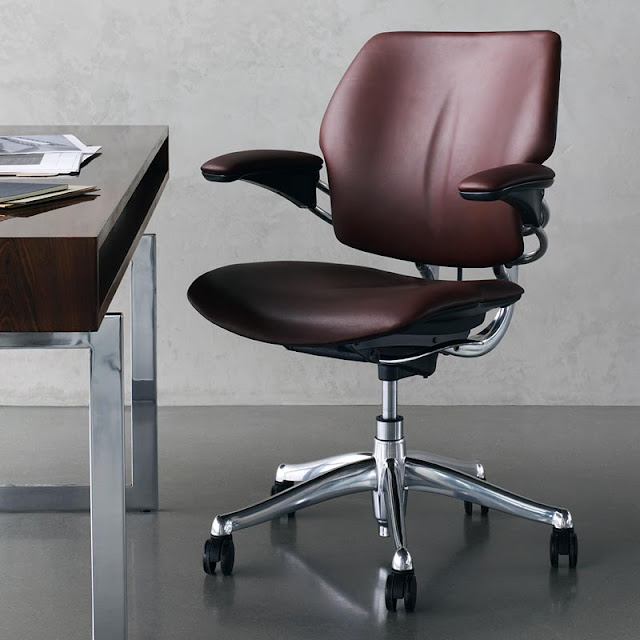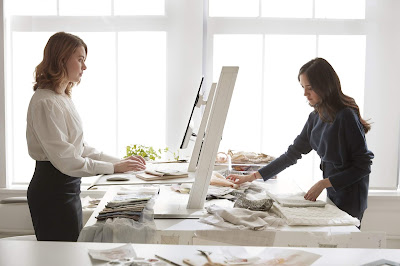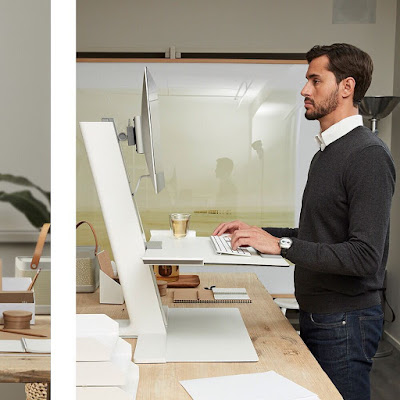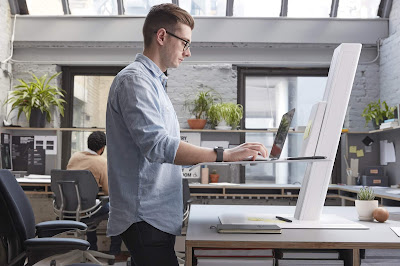5 ESSENTIALS
FOR THE “PERFECT” WORKSTATION
In the field of manufacturing
ergonomic tools well designed for the workplace for over 35 years, Humanscale
and its team of certified ergonomists know that the ideal workstation is much
more than just a chair or a desk. There are several key factors to consider in
ensuring that a workstation is functional and adaptable, as well as comfortable
and healthy for the user. The leader in durable ergonomic tools for the
workplace has prepared a checklist for creating a better workplace, suitable
for home or office use.
1. The Chair
Finding the perfect work chair is an important first step when creating a
healthy and comfortable work space. Jonathan Puleio, certified ergonomist and
global vice president of consulting at Humanscale, focuses on the correlation
between a person's comfort at work and their overall experience. He suggests
that a comfortable ergonomic chair can lead to increased alertness as well as
increased blood flow, which benefits a person's well-being. "A good work
chair can provide you with the best possible foundation for creating great
work," he says. Puleio suggests looking for a chair that automatically
adapts to the seated person so that you don't have to fumble with confusing
buttons and levers to be comfortable when changing tasks and positions
throughout the day. Any adjustment that is not automatic, such as the height
and height of the armrest, should be easy and intuitive. One chair that Puleio
recommends is the Liberty chair by Humanscale which, like all Humanscale
chairs, offers a self-adjusting, weight-sensitive recline with a swivel
backrest that provides lumbar support for all sitting positions.

For decades, office furniture has been designed to be stationary, and people
have had to adjust their physical position around the tools at their
workstations. Ergonomists now know that it is important for people to be able
to move around freely throughout the day in order to be healthy, comfortable
and focused at work. Furniture should adapt to the professional who uses it,
not the other way around. Anxious to put people first, Humanscale designs all
of its furniture, including desks, to move with the user while he works. A good
sit/stand desk should be simple, intuitive, and easy to use, so if a person
needs to get up or sit while working, the process of lifting or lowering the
desk is seamless. The Humanscale Float desk, for example, has a built-in
counterweight mechanism that accepts loads of varying weights. So by pressing a
contoured lever under the work surface, raising or lowering the desk is as
quick and easy as sitting or standing and does not interrupt the workflow.

3. The Lighting
Natural light in the workplace is widely recognized as a positive influence on
productivity, creativity, and mood, but is just one of the many sources of light
needed to fully ensure well-being at work. With the rise of backlit screens and
open floor plans, work lighting, in addition to natural or aerial lighting, is
necessary for optimal work experience. "To avoid eye discomfort which
can have a negative impact on performance as well as on their health and
well-being in general, it is important to find appropriate working lighting
which projects a large footprint, ie without glare and offers a single shade
that is smooth and easy to adjust needs evolve throughout the day, ”says
Puleio. The adjustments a projector should be able to make include both manual
positioning and brightness levels. The Horizon 2.0 by Humanscale is a desk lamp
that meets these needs. It reduces eye strain and improves overall comfort by
providing glare-free light that intuitively adapts to a range of activities,
from reading documents to writing emails, and everything in between.
Although often overlooked, the monitor arms provide a clutter-free workspace
and support a healthier and more ergonomic work posture, making it essential
for the ideal office setup. Many professionals tend to lean toward their
computer screen for better viewing, while the monitor arms allow them to pull
the monitor closer so that they can sit in a healthy posture with their backs
against the back of the work seat, and always see the work on their screen.
Users are encouraged to align the monitor at the correct height for them, which
helps prevent eye and neck fatigue. Monitor's arms are also essential for professionals
who use multiple monitors to manage their work.
5. The Keyboard Tray
Another essential tool for creating an adaptable and ergonomic workspace is a
keyboard tray. This underestimated tool brings the keyboard and the mouse
closer together and encourages professionals to sit in a healthy and neutral
posture without leaning forward. A well-designed keyboard tray provides
protection against carpal tunnel syndrome, neck and back pain, and other
musculoskeletal problems. Other ergonomic tools, including NeatTech, NeatUp and
NeatLink from Humanscale, help keep the office safe from cables and clutter.
Each of these tools working in
harmony to offer ergonomic support and comfort, everyone can have a
"perfect" workstation.
Contact Us for More Info:
Humanscale Bangalore - 097423
29159
Humanscale Hyderabad - 098850
51419
Humanscale Mumbai - 062621 51514


























